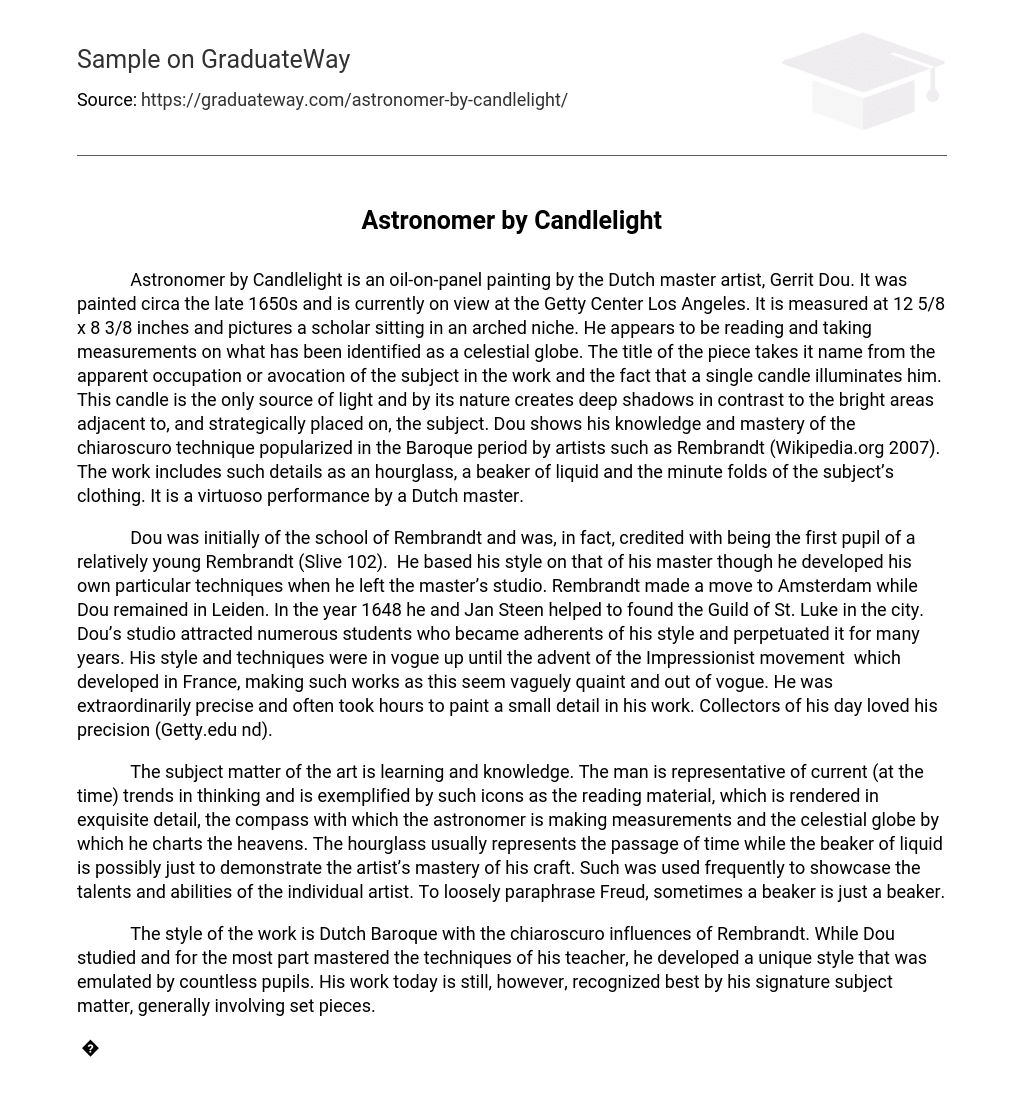Astronomer by Candlelight is an oil-on-panel painting by the Dutch master artist, Gerrit Dou. It was painted circa the late 1650s and is currently on view at the Getty Center Los Angeles. It is measured at 12 5/8 x 8 3/8 inches and pictures a scholar sitting in an arched niche. He appears to be reading and taking measurements on what has been identified as a celestial globe.
The title of the piece takes it name from the apparent occupation or avocation of the subject in the work and the fact that a single candle illuminates him. This candle is the only source of light and by its nature creates deep shadows in contrast to the bright areas adjacent to, and strategically placed on, the subject. Dou shows his knowledge and mastery of the chiaroscuro technique popularized in the Baroque period by artists such as Rembrandt (Wikipedia.org 2007).
The work includes such details as an hourglass, a beaker of liquid and the minute folds of the subject’s clothing. It is a virtuoso performance by a Dutch master. Dou was initially of the school of Rembrandt and was, in fact, credited with being the first pupil of a relatively young Rembrandt (Slive 102). He based his style on that of his master though he developed his own particular techniques when he left the master’s studio. Rembrandt made a move to Amsterdam while Dou remained in Leiden.
In the year 1648 he and Jan Steen helped to found the Guild of St. Luke in the city. Dou’s studio attracted numerous students who became adherents of his style and perpetuated it for many years. His style and techniques were in vogue up until the advent of the Impressionist movement which developed in France, making such works as this seem vaguely quaint and out of vogue. He was extraordinarily precise and often took hours to paint a small detail in his work. Collectors of his day loved his precision (Getty.edu nd).
The subject matter of the art is learning and knowledge. The man is representative of current (at the time) trends in thinking and is exemplified by such icons as the reading material, which is rendered in exquisite detail, the compass with which the astronomer is making measurements and the celestial globe by which he charts the heavens. The hourglass usually represents the passage of time while the beaker of liquid is possibly just to demonstrate the artist’s mastery of his craft. Such was used frequently to showcase the talents and abilities of the individual artist. To loosely paraphrase Freud, sometimes a beaker is just a beaker.
The style of the work is Dutch Baroque with the chiaroscuro influences of Rembrandt. While Dou studied and for the most part mastered the techniques of his teacher, he developed a unique style that was emulated by countless pupils. His work today is still, however, recognized best by his signature subject matter, generally involving set pieces.
While canvas had been popular as a support for years Dou still chose to paint this work on wood. The panel may have been an attempt on his part to avoid the aging that occurs to a work on canvas with the shrinking and stretching of woven material. His oils were hand ground and applied in the traditional method of glazes in the shadows and impasto in the lights.
The composition is rectangular to offset the shape of the panel, which is arched at the top. The central figure, his face, hand and candle drawing the eye, dominates the work. The balance of the objects fade out the further from the light they are placed. Still the detail of the material and the folds of the subject’s coat are rendered in sharp focus and minute detail, though there is an almost claustrophobic air to the overall work.
The painting does not speak to me on a gut level and while I recognize the hand of a master at work in the piece, I find it boring and think of it more as an exercise than a fitting subject for a finished piece. It seems to lack dynamics and movement. It is as if it were done in a factory, frozen in time and evoking little emotion from me. It’s rendered masterfully, but I would not choose to include it in my collection.
Works Cited
- Getty.edu Astronomer by Candlelight ca. 1650s Gerrit Dou Retrieved 6-3-07 From: http://www.getty.edu/art/gettyguide/artObjectDetails?artobj=922
- Slive, S. Dutch Painting: 1600-1800 Singapore: Yale University Press 1995
- Wikipedia.org Gerrit Dou 2007 Retrieved 6-3-07 from: http://en.wikipedia.org/wiki/Gerrit_Dou





